Declining Reproductive Potential of the Alligator Population on Lake Griffin in Central Florida
Abstract
The alligator reproductive potential or capacity for hatchling production of Lake Griffin in Central
Florida has sharply declined since 1993. The reproductive potential for 1997 was less than 5% of the level in 1993. Causes of
this decline initially were a decrease in egg production but later a dramatic drop in the hatch rate of fertile eggs became the
principle problem. There was a steady decrease in nests on the lake from 1992 until 1994 which caused decreased egg production
but the percentage of eggs that were fertile and the hatch rate of the fertile eggs did not significantly change. The number of
nests on the lake remained relatively constant from 1994 until 1997 and the clutch size (number of eggs in the nests) did not
appreciably change. However, physical characteristics of the eggs and particularly the hatch rate did change. The decrease in
hatch rate was the primary cause of the dramatic decrease in potential hatchling production between 1994 and 1997. Physical
characteristics of the eggs began to change in 1993. Egg size significantly and progressively decreased from 1993 through 1997
and the percentage of egg represented by yolk significantly and progressively increased. The shape of the egg changed and the
percentage of the egg represented by shell significantly decreased between 1993 and 1997. A comparison of the yolk percent and
shell percent of the 1997 eggs from Lake Griffin with several thousand eggs from all lakes and farms which had been studied over
the past decade showed that yolk percents were significantly higher and shell percents were significantly lower for the 1997
Griffin eggs. Hatchlings from Lake Griffin in 1997 had a significantly lower growth rate than controls but no difference was
detected body fat based on body condition scores. Changes in egg shape and composition parameters suggested that a toxin or
nutritional problem may be contributing to the decline in reproductive potential on lake Griffin.
Introduction
Lake Griffin is a large (14,200 acres) shallow lake in North Central Florida that is a member of lakes in
the Ocklawaha drainage group. It was formally studied from 1981 to 1991 by the Florida Game and Freshwater Fish Commission (GFC)
and the Florida Cooperative Fish and Wildlife Research Unit (1,2). The studies included several facets of the alligator
population including a reproductive parameter, clutch viability, which was defined as the percentage of total eggs in a clutch
that hatch (1). Although clutch viability varied over the years no trend was reported and the cause of the variance was not
identified (1,2). Florida alligator farmers have collected eggs from about half the alligator nests on Lake Griffin since 1991
and the viable fertile eggs (live embryo) artificially incubated. Hatch rates were not always determined in a controlled manner.
Our laboratory began monitoring eggs collected from the lake in 1993 to determine the quality of the eggs and their potential
for hatchling production. Egg quality was determined by egg fertility, physical properties of the eggs such as size and shape,
shell characteristics, membrane properties, yolk and white parameters, capacity of fertile eggs for embryonic development, and
the vigor of hatchlings produced (3,4,5). Reproductive potential of the lake consisted of egg production, percent fertile eggs,
percent of the fertile eggs determined to be viable or projected to produce a hatchling, hatch rate of viable eggs, and vigor or
growth performance under optimal conditions of the hatchlings (3,4,5). In 1994, a slight decline in reproductive potential of
the lake was observed that continued in 1995 and significantly decreased in 1996. By 1997, reproductive potential had decreased
to less than 5 percent of its level in 1993. This report describes changes in egg quality parameters that caused the decline in
reproductive potential for Lake Griffin.
Materials and Methods
Nests and Eggs
The GFC made nest counts and determined nest locations. Nests from around the lake were identified by the
GFC and collected by Florida alligator farmers, primarily based on their availability. An experienced farmer made the
identification of viable eggs from fertile eggs, at the site. The Florida alligator farmers purchased eggs designated as viable
which were surrendered by the GFC. Eggs identified as fertile but not viable (dead embryo) were retained by the GFC and
identified as fertile discards. Eggs with no gross evidence of embryonic development (opaque banding resulting from attachment
of embryonic membranes to the egg membrane) were identified as infertile and retained by GFC.
The farmers donated a random sample of 3 fertile eggs to our laboratory and a random sample of 3 infertile
eggs was donated by GFC. Samples from 41 to 52 clutches (nests) were collected for our study. The average egg sample collected
from each nest was an estimated 7% of the eggs in the clutch (mean clutch size over a 15 year period was 46 eggs). The mean
percentage of the total nests sampled annually on Lake Griffin during the study period was 32% (S.D.=5.3%) with a range of 25%
to 35%. A mean value of 162 nests had been observed annually on the lake over a 12-year period from 1985 to 1997. Fertile eggs
were placed in trays of moist sphagnum moss and the trays incubated at 31 C in a low temperature incubator. A control sample of
3 infertile and 12 fertile eggs from each of 12 clutches was collected from the Rockefeller Refuge in Southwest Louisiana.
Conditions of incubation, egg treatments and hatching techniques have been described (3,4,5). The following measurements and
calculations were made on the infertile eggs: 1) egg length; 2) egg width; 3) egg weight; 4) egg volume; 5) calculated egg
volume; 6) volume error (% deviation of calculated volume from the measured volume); 7) length/width ratio; 8) shell weight; 9)
shell thickness; 10) shell density; 11) yolk weight; 12) membrane weight; 13) % yolk; 14) % white; 15) % shell; 16) % membrane.
The stage of development at the time of embryonic death was determined for embryos that were dead on arrival or died during
incubation by the use of a developmental stage chart showing normal embryo development for incubation techniques used in our
laboratory (5). Growth potential of the hatchlings was determined by their growth performance at low stocking densities in a
temperature-controlled house with daily feeding to satiation of a high performance diet (3,4,5). The following measurements or
calculations of hatchling growth performance were made: 1) day-1 length (all lengths are total lengths); 2) day-180 length; 3)
day-1 weight; 4) day 180 weight; 5) hatchling yield from the egg (% of the egg represented by hatchling weight at day-1); 6)
day-1 condition factor; 7) day-180 condition factor; 8) 180 day growth rate (cm/day); 9) 180 day performance. Descriptive
statistics including a stem-and-leaf plot (or a horizontal bar chart), a box plot and a normal quantile plot were made using the
SAS statistical package.
Potential Hatchling Production
The potential hatchling production or capacity for hatchling production is a calculated value determined
from nests on the lake, clutch size, percentage of fertile eggs in a clutch and the hatch rate of the fertile eggs (percentage
of fertile eggs that hatch). The product of these terms is equal to the potential hatchling yield for the lake but it does not
consider factors such as nest flooding, nest predation and age of the fertile eggs used to determine hatch rate. A hatchling
must grow more than 0.07 cm per day to be considered viable.
| Figure 1. | 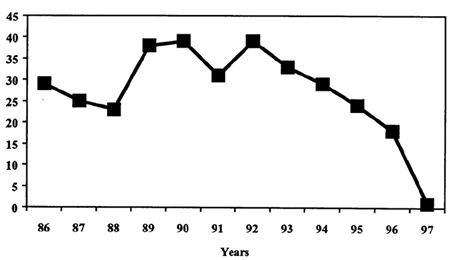
Potential hatchling yield per 100 acres of Lake Griffin. |
|
| |
Results
Potential Hatchling Production (Figs. 2 & 3)
Nests on Lake Griffin declined by 38% between 1992 (207 nests) and 1997 (128 nests) with the sharpest
decline (Fig 1) occurring between 1992 and 1993 (163 nests). Annual clutch size has remained almost constant between 1983 and
1996 with a mean value of 45.8 eggs per clutch (S.D.= 1.5, n=14) but decreased 12% to a mean value of 40.5 (S.D.=11.1, n=45) in
1997 (Fig 2). Egg yield in 1997 (5,184 eggs) for the lake decreased (30%) from the 15 year mean value of 7,378 eggs (Fig 3). The
potential hatchling yield decreased 97.3% in 1997 from a 12 year (1983 to 1995) mean value of 4,406 (S.D.= 817) hatchlings to
133 hatchlings (Fig 1). The sharpest decrease in potential hatchling yield occurred between 1996 and 1997. The percentage of
eggs that were fertile in 1997 was 72.7% which is a decrease of 17% from the 14 year mean value of 87.6 %. The percentage of
fertile eggs that hatch decreased from 71.4% in 1993 to 3.3% in 1997. The 180-day growth rate of Griffin hatchlings (0.142 cm
per day, S.D. = 0.022, n=7) was significantly less (30%) than a control group from the Southern Everglades (0.184 cm per day,
S.D.=0.037, n=10). Ninety six percent of embryonic deaths occurred before 10 days of normal development.
| Figure 2. | 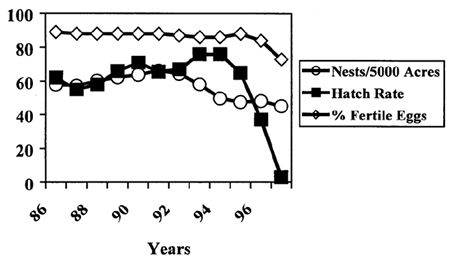
Running averages nests, hatch rate, % fertile eggs. |
|
| |
| Figure 3. | 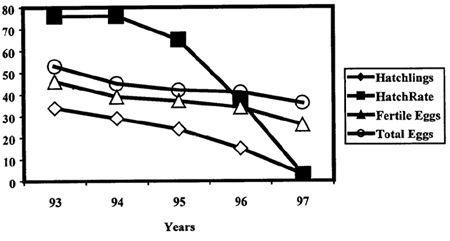
Running averages total eggs, fertile eggs, hatch rate & potential hatchling
production per 100 acres. |
|
| |
Physical Characteristics of the Lake Griffin Eggs (Figs. 4 & 5)
Mean egg length decreased 2.2% from 7.57 cm in 1993 to 7.40 cm in 1997 and egg width decreased 2.0% from
4.50 cm in 1993 to 4.41 cm in 1997. The eggs were significantly shorter (0.17 cm) in 1997 compared to 1993 and the length/width
ratio decreased by 2.3%. Mean egg weight significantly and progressively decreased (14%) between 1993 (89.6 g) and 1997 (77.3g)
(Fig 4). The mean percentage of egg represented by yolk significantly and progressively increased (42%) between 1993 (40.6%
yolk) and 1997 (57.8% yolk). The physical integrity (firmness) of the yolk visibly deteriorated during the study period. Changes
in physical properties of the egg membrane detected over the study period were not significant. Mean percent of the egg
represented by shell significantly decreased (10%) between 1993 (11.03% shell) and 1997 (9.96% shell). The changes were
significant for the entire period but not progressive. The 1997 mean percent shell level was significantly lower than the mean
percent shell level for all farms and lakes studied from 1988 to 1997 (10.6%, S.D. 1.25, n=4,596). Mean shell thickness
decreased (3.7%) from 1993 (0.461 mm) to 1997 (0.441 mm); while, mean shell density increased (3.8%) from 2.25 in 1993 to 2.34
in 1997. Changes in shell thickness and density were not statistically significant.
| Figure 4. | 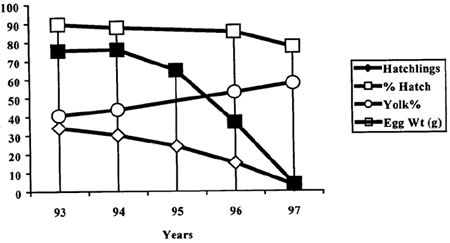
Running averages hatchlings, hatch rate, % yolk, egg weight. |
|
| |
| Figure 5. | 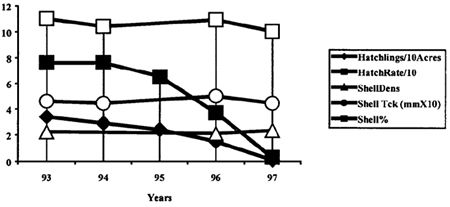
Running averages hatchlings, hatch rate, yolk weight % yolk, egg weight. |
|
| |
Discussion
We believe that the recent sharp decline in 1997 of potential hatchling production on Lake Griffin began
in 1993 (Fig 1). The major detectable effect for 1993 was decreased egg production caused primarily by a 20% decrease in nests
(Fig. 2). The percent fertile eggs, clutch size and hatch rate did not significantly change in 1993 and1994. Hatchling yield
decreased in 1994 with the primary problem again being low egg yield caused by a 25% decrease in nests. Hatch rate, clutch size
and percent fertile eggs were not markedly different in 1994 but physical properties of the eggs had changed. Egg size
decreased, percent of the egg represented by yolk increased and physical integrity of the yolk deteriorated in 1994 (Fig 3).
Changes in egg membranes, percent shell, shell thickness and shell density were observed but did not seem closely associated
with changes in hatch rate (Fig 5). Physical changes in the eggs may represent a problem with the breeders that resulted in
fewer nests and caused egg yield to decrease but the effect had not yet caused a decreased in percentage of fertile eggs or
their hatch rate in 1993 and 1994.
Nests and egg yield did not significantly change between 1994 and 1997 (Fig 2) but hatchling yield sharply
decreased principally caused by a dramatically falling hatch rate of the fertile eggs (Figs. 2 & 3). Growth rate of the 1997
hatchlings was significantly lower than controls but body condition and percent body fat were not significantly different. The
problem appears to first affect the breeders causing a reduced egg yield and physical properties of the egg but later causes the
decreased hatch rate. Decreased egg quality may also be seen with the decreased growth rate of hatchlings. The cause of a
decreasing hatch rate is not known but the data on changes in physical properties of the eggs suggest a toxic or nutritional
problem.
Acknowledgements
The authors wish to thank the Florida alligator farmers, the Florida Game and Freshwater Fish Commission
and especially Mr. Arnold M. Brunell and Mr. Allen R. Woodward heir for providing their information and assistance. Mr. Wayne T.
McClellan and Mr. Joseph P. Cardeilhac provided technical assistance.
References
1. Woodward AR, Percival HF, Jennings ML, Moore CL. (1993) Low Clutch Viability of American
Alligators on Lake Apopka. Florida Scientist 56: 52-63.
2. Mason GR. (1995) Environmental Influences on Reproductive Potential, Clutch Viability and
Embryonic Mortality of the American Alligator in Florida. PhD Dissertation. University of Florida, Gainesville Florida. 123 pp.
3. Cardeilhac PT. Diagnosis and Treatment of Infertility in Captive Alligators. Final Reports
for the Aquaculture Market Development Aid Program. Vols I-III. 1987-1991. Florida Dept. of Agriculture, Tallahassee, FL
32399-0810.
4. Millstein SR, Vander Meer RK, Schoenagle EM, Cardeilhac PT. (1994) Dietary Therapy for Egg
Fertility in the American Alligator: An Evaluation by Determining Fatty Acid Profiles of Egg Yolk. Proceedings International
Association for Aquatic Animal Medicine. 25:10-15.
5. Cardeilhac PT, Hoffingberg ML. Development of the Alligator. A Color Poster to Grossly Identify
Developmental Stages of Normal Embryos Incubated at 88 F (31 C). 1985 Aquatic Animal Laboratory, College Of Veterinary Medicine University of Florida, Gainesville FL.